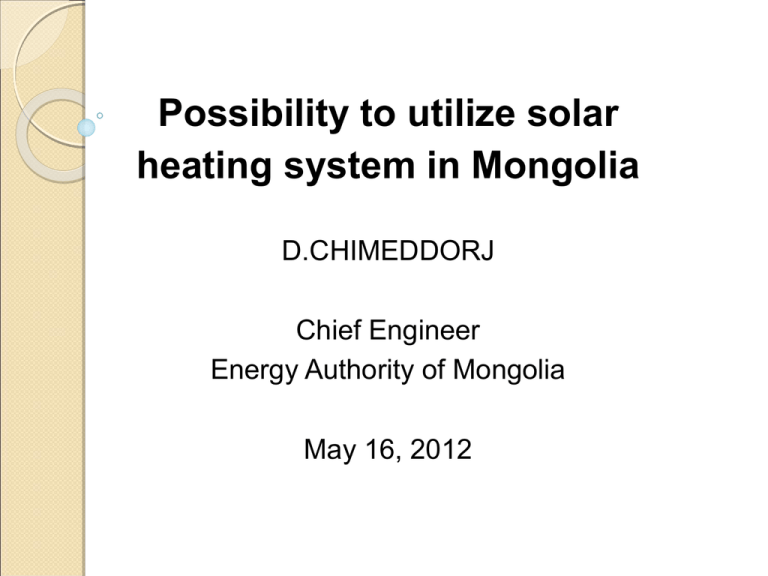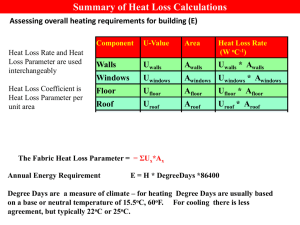Possibility to utilize solar heating system in Mongolia
advertisement

Possibility to utilize solar heating system in Mongolia D.CHIMEDDORJ Chief Engineer Energy Authority of Mongolia May 16, 2012 Contents Introduction Background The burning platform Solar Energy study in Mongolia Solar heating concepts Soum and Aimag heat demand Heat demand and Generation in UB Solar heating technology Connecting to District heating network Economic overview Conclusion Background information Mongolia has an extremely harsh winter climate Winter temperature range is -10 C to -30 C in the daytime Temperature drop is -40 C at night. Long heating season, with a total of eight months from the middle of September to the middle of May. Background information Ulaanbaatar (UB) is the coldest capital city in the world. The air quality is dangerously bad - UB is becoming the world’s most polluted city. In UB, annual average particulate matter concentrations have been recorded at as high as 279. World Health Organization recommended PM10 level is 20. UB’s PM10 levels are 14 times higher than the WHO’s recommendation. Background information The heating demand is continuously increasing. The heat supply in Mongolia is mainly provided from combined heat and power plants. The energy source is mainly coal which, despite co-generation, contributes to carbon emissions. The burning platform From a global perspective the increasing global fuel prices, local environment (air pollution), limitation of fuel reserves and extensive amount of available solar resources, creates a burning platform for solar heating in district heating systems around the world. The burning platform In northern Europe the solar heating systems are not only an environmental friendly solution, but also cost-efficient compared to other solutions. Furthermore, systems designed for solar heating has a tendency to be more efficient than traditional district heating systems, as temperature levels has been considered, heat storage tanks and other technical solutions has been utilized. The burning platform Solar heating solutions have been used world wide for decades, not to say centuries, but have most often been relatively simple solutions with i.e. a tank on the roof with lack of controlling etc. However, the technology has been matured over the last decades where large scale solar heating plants have been constructed and connected to existing district heating systems. The technology is now days robust and can operate in both harsh winter climate and hot summer climate. Solar Energy study in Mongolia The research started since 1961 Insolation of the direct radiation Insolation of the diffuse radiation Insolation of the total radiation Average irradiance in hours per day Solar Radiation Map of Mongolia Ministry of Education, Culture and Science - in 2010 Solar Radiation Map of Mongolia Insolation of radiation annually /DNI/ № Regions \by color\ Potential \ kWh/m2\ 1 800-930 2 930-1060 3 1060-1190 4 1190-1320 5 1320-1450 6 1450-1580 7 1580-1710 8 1710-1840 9 1840-1970 10 1970-2100 DNI In Mongolia the annual irradiation is 1350-1850 kWh/m2 and as illustrated in table the annual irradiation in Ulaanbaatar is above 1800 kWh/m2. Which placements are feasible for Solar Thermal Plant? Classification of regions by the Annual Direct Normal Irradiation (DNI) Excellent (>2200 kWh/m2・a) Good (>2000 kWh/m2・a) Acceptable (>1800 kWh/m2・a) Low (<1600 kWh/m2・a) Example: DNI in China? Large zones with more than 2400 – 2600 kwh/m2/year !!! Solar heating concept Soum and Aimag heat demand Heat demand and Generation in UB Solar heating technology Connecting to District heating network № Aimags Heating demand, Gcal/h Hot water demand, Gcal/h Total Demand Gcal/h MW/h 1 Dundgobi 9.25 9.25 7.96 2 3 4 5 6 7 8 9 10 11 12 13 14 15 16 17 Dornogobi GobiSumber Bulgan Huvsgul Sukhbaatar Khentii Bayankhongor Uvurkhangai Arkhangai Uvs Khovd Gobi-Altai Zavkhan Selenge Tuv Bayan-Ulgii 13.4 5.6 9.7 15.9 11.6 10.94 13.41 3.04 10.87 11.4 11.3 14.7 13.86 28.5 18.68 15.8 13.4 5.6 9.7 15.9 11.6 10.94 13.41 3.04 13.72 12 11.9 14.7 14.03 28.67 18.68 15.8 11.52 4.82 8.34 13.67 9.98 9.41 11.53 2.61 11.80 10.32 10.23 12.64 12.07 24.66 16,06 13.59 222.34 191.21 Total 217,95 2.85 0.6 0.6 0.17 0.17 4.39 Main Performance Indicators of Existing Boilers in Soums No. Items Argalant Airag Mogod Tsetse rleg 1 Boiler type NR-18-54 NR18-54 BZUI100 NR-1854 0.38 0.7 0.38 Bayan chand mani CLSG95-70 Bayan gol KhutagUndur TsagaanUul Ikh-Uul NR-1854 BZUI-100 DTH-0.7 ANDI-20 0.38 0.73 Design capacity (Gcal/h) 0.38 3 No. of boilers installed 2 3 2 3 1 2 4 Type of coal burnt Baganuur lignite coal Shive eOvoo lignit e coal Bayand uuh bitumino us coal Mogoi ngol bitumin ous coal Nalaik h bitumin ous coal Bagan uur lignite coal 2 Zaamar NRJ-45 BZUI-100 Tument sogt Delgert sogt Jargalant BZUI100 NR6J/10J/1 6J/25J RJ-18 0.7 0.7 0.8 3 0.3 0.43 0.7 0.43 0.7 2 SaikhanOvoo bitumi 2 2 3 2 5 Mogoingol bituminous coal Saikhan Ovoo lignite coal Zaamar-Ikh lignite coal Talbulag lignite coal Tevshiin govi coal -nous coal Sharyngol lignite coal 5 Annual coal consumption (t/yr) 1,200 3,900 1,200 1,000 533 1819 690 510 724 1,280 2,053 565 1,100 6 Maximum Boiler efficiency (%) 60.3 60.3 56.2 60.3 46.1 60.3 50.8 59.3 57.2 50.0 50.8 45.0 50.0 7 Supplied water temp. (0C) 70 80 80 75 50 50 60 75 60 60 60 60 60 8 Returned water temp. (0C) 60 65 65 65 42 40 65 65 40 40 40 40 40 36.5 27.5 35 31 53.7 74 40 - 90 - - - - 9 Circulation water flow ( t/hr) 10 Outdoor heating design temp. (0C) -33.9 -29.1 -25.2 -35.6 -30.2 -39.4 -30.9 -31.3 -30.0 -31.3 -27.2 -28.1 -33.4 11 No. of boiler workers 11 23 14 23 6 20 10 10 36 17 17 14 21 12 Existing heat demand (MW) 0.8 0.67 0.35 0.77 0.8 1.44 0.8 0.72 0.74 0.87 0.9 0.3 0.9 0.82 0.96 0.62 0.8 0.82 1.91 1.0 0.93 0.75 1.00 1.0 0.5 1.0 13 Total heat demand Power performance Gcal/h Connected consumption Gcal/h Difference TPP-2 TPP-3 TPP-4 Total 57 485 1045 1585 52 485 960 1495 5 0 85 90 Solar heating technologies There are four main technologies within solar thermal technologies: Central Receiver Tower Plant Parabolic solar unit Evacuated tubes Flat plate collectors Central Receiver Tower Plant Concentrates solar radiation on a point receiver at the top of a tower Enables operation at high temperature level and provides heat storage capabilities Has high net solar to electrical efficiency and is a commercially proven technology Solar Thermal Plant with Central Receiver Receiver Central Receiver Tower Helioltats Heliostat reflectors Energy Conversion system Power Conversion System Parabolic solar unit A trough-shaped parabolic reflector is used to concentrate sunlight on an insulated tube (Dewar tube) or heat pipe, placed at the focal point, containing coolant which transfers heat from the collectors to the boilers in the power station. Temperature range: 0-400°C Parabolic solar unit Evacuated tubes Evacuated heat pipe tubes are composed of multiple evacuated glass tubes each containing an absorber plate fused to a heat pipe. The heat from the hot end of the heat pipes is transferred to the transfer fluid of a domestic hot water or hydronic space heating system in a heat exchanger called a “ manifold ” . Temperature range: 0-150°C Evacuated tubes Flat plate collectors The solar energy is transformed into heat by the absorber which is located in the inside of the solar collector. It absorbs the solar heat and transmits it to a frost-resisting liquid which circulates in a system of pipes. The heated liquid is lead to a warm water tank, store tank or a separate heat exchanger. Temperature range: 0-120°C Flat plate collectors Connection to District Heating network District Heating networks in Mongolia, are most often divided into primary and secondary networks. The primary network can be seen as a transmission network where substations equipped with heat exchangers are separating the primary and the secondary network. The secondary networks are distributing heat to a number of dwellings. Connection to District Heating network The temperature levels on the primary network are often 130/70, sometimes up to 150/80. The temperature levels on the secondary networks are typically in the range of 95/70. Connection to District Heating network There are several ways to connect solar heating units to a district heating network. Most common way is solar heating units in combination with heat storage tank connected to the secondary network thru a heat exchanger. The hot water from the solar heating units is mixed with the supply water from the substation (when necessary). The storage tank can be used to level the variations in heat demand and solar heat resources for optimal utilization of the resources. Connection diagram Secondary network installation with heat storage tank Cold water storage Heat conversion Hot water storage Solar field Main scheme Operating process Cost estimation The cost for Turn-key solar heating equipment/plant is estimated to 500800 USD/m2. For a typical soum center heating area of 10'000m2 with 1Gcal/h peak demand and assuming that 25% of the heat comes from solar panels, the cost would be 0.25-0.42 million USD. Conclusion Use Solar Thermal Energy: • for heating system of the Aimag centers • for central heating system of the Soums’ centers • for heating system of Ulaanbaatar’s districts • Infrastructure development by Government • Using investment opportunities as a cooperation between government and private sector Recommendation Solar heating system ◦ Provide FS for Solar heating system of Soum and aimag center. ◦ Provide FS for Solar Heating system in UB Ger area and/or Support UB district heating network FS for Solar Thermal PP in grid connection Implement Pilot project





